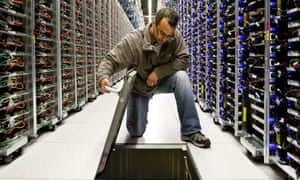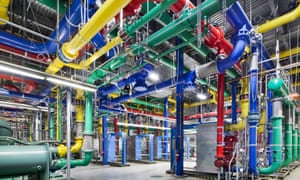THE TECH INDUSTRY IS THREATENING TO DRINK CALIFORNIA DRY
With California thought to have only one year of water left, Silicon Valley data centres are trying to reduce their needs for cooling

We hear a lot about what the tech giants are doing with our data, but what are they doing with our water?
Water keeps our internet-based economy afloat by ensuring equipment in data centres stays cool enough to funtion. Yet in California, the drought-ravaged epicenter of the technology industry, water is in ever-shorter supply. Nasa scientist Jay Famiglietti predicts the state has only one year of water left. This raises serious questions about the environmental impact of our burgeoning data demands.
The source of the problem
Water use in data centres has “flown under the radar for the longest time” but it’s something companies are starting to get to grips with, says Jack Pouchet, a board member with The Green Grid, a non-profit that promotes resource efficiency in information technology.
Water-cooled data centres use an estimated 13.25m litres (3.5m gallons) per MW each year, according to Pouchet. The data centres used by major players can range in scale from 5MW to 30MW. And with an estimated 800 data centres in California, those numbers add up.

These consumption levels can be traced to the industry’s historical concern with its power use. Data centres tend to use the power usage effectiveness standard (PUE), a metric developed by The Green Grid to gauge the efficiency of computer facilities. PUE, however, does not take water consumption into account. The result has been a shift to energy-efficient but water-intensive cooling methods.
“People have driven the efficiency up and the power consumption down,” says Peter Hopton, founder of Iceotope, a data centre cooling start-up based in the UK. “But one of the things that has been introduced to drive that has been evaporating water.”
Turning the tide
Now that California has imposed mandatory water restrictions to cut the state’s water use by 25%, general awareness of water scarcity is growing, and the possibility of higher water prices looms. Data centre owners and managers have taken notice and started looking for ways to cut water use.
For Vantage Data Centers, which runs three facilities on its campus in Santa Clara, the solution has been smarter buildings. Two of the company’s centres are cooled by a conventional system that channels cold water through the room. The used water is pumped through a cooling tower, over the outside of which more water is run, which then evaporates, drawing heat from the piped-in water.
Vantage, however, has minimised the amount of water-cooling required by installing air handling units that can, when conditions are appropriate, pull air in from outside to cool the room. Weather stations that measure temperature, humidity and dewpoint are deployed around the campus; when they agree conditions are right, the system automatically switches to air-cooling mode.
“The building opens up to outside air and sucks it straight into the air handlers,” says Vantage’s chief operating officer Chris Yetman. “That central chilling plant slows way down or even shuts off.”
Key to the strategy is convincing customers to let go of preconceived notions about how cool is cool enough for data centres. Traditional standards set the acceptable temperature range at about 18C to 27C. Today, however, technological advances mean wider ranges of both temperature and humidity are safe for most equipment, says Yetman. When tenants agree to work within these broader ranges, less water – and less money – is needed to achieve the perfect climate.
“We work with customers to explain to them: ‘look, you’re missing out on savings here’,” says Yetman.
The water challenge
Digital Realty, which operates 3.5m square feet of data centres throughout California, has responded to the governor’s call for reduced water usage by launching an internal water conservation challenge, says sustainability director Aaron Binkley. As part of this, the company is working with local water utilities to determine where and how it can use recycled rather than potable water in its cooling systems.
“We’re asking, ‘is that quality good enough for us to use, is the supply sufficient for our needs, is it reliable, is it cost effective’,” says Binkley.
Digital Realty’s efforts also include less dramatic yet still essential elements, such as reviews of internal processes to ensure equipment is precisely calibrated, optimally cleaned and serviced in the most efficient fashion.
Energy efficiency and sourcing are also important considerations. In California, power production is second only to agriculture in the amount of water it consumes, so cutting electricity use or buying energy from less water-intensive sources can shrink a data centre’s overall water footprint.
Equinix, one of the largest data centre companies in the US, recently announced plans to install a 1MW biogas-powered fuel cell at one of its Silicon Valley centres, reducing the amount of energy it needs to buy from fossil-fuel burning plants. The purchase is part of Equinix’s long-term plan to use 100% renewable energy.
The greatest hurdles
But obstacles remain to data centres tackling water scarcity. Largest among these: money. Water-efficient systems are often more costly than the alternatives, and water prices have not yet risen to such a degree that limiting water use would pay for itself, says Todd Boucher, founder of New Hampshire data centre design company Leading Edge Design Group.
“People are still choosing to go with designs that are more water-intensive because of the cost of construction,” he says.
The need for proximity is another challenge. Many companies have opted to locate some of their data centres in climates where facilities can be cooled by the outside air year-round, such as Facebook’s data centre in Luleå, Sweden. But for applications such as high-speed processing, data centres simply need to be close to end-users, wherever they live.
Despite these barriers, businesses are finding viable water-saving options, says Will Sarni , practice leader for water strategy at Deloitte Consulting.
“We live in a world where data goes into this mysterious cloud but it actually does have a physical presence,” he says. “And the physical presence absolutely can be part of the solution.”







Even if the average data center is 15 MW and uses 52.5 million gallons annually all 800 data centers only use a bit over 129,000 acre-feet, which is only enough to supply about 650,000 people on an annual basis in a pinch (not including water used to produce their food). The power industry uses a good deal more than that for cooling, (51 times as much according to the USGS (2014) as would any large hot metal business that uses water for cooling too. I know that Kaiser Steel in Fontana is long closed but in its day it would have used more water than all the big data centers in California put together to cool hot steel.
Of course then there is the oil & gas drilling and refining industry and its level of water use too. Figure this. Every gallon of gasoline used in California requires 10 or more gallons of water to produce as does every cubic foot of natural gas sold too, and one of the biggest problems with fracking and directional drilling is that the water they use is permanently contaminated and can’t be reused, as right now the cost to clean it to any reuse standard is prohibitive.
The largest water-user by-far is still agriculture. In a study that I did of the Rio Grande Basin several years ago I noted that the senior users in the Elephant Butte irrigation District were receiving three acre-feet per acre in-production from the water district, plus any rainfall that they received, plus any irrigation drawn from aquifers too. They also grow pecans as well as a number of pepper varieties and a few other crops. Peppers do not consume nearly the amount of water that pecans do.
Now the Elephant Butte Irrigation District only serves 178,000 acres (278 square miles) times 3 acre-feet (325,851.43 gallons per acre-foot), let’s just round it off to 1 million gallons, which equals 178 billion gallons, which does not include any rainfall or any irrigation drawn from aquifers either. Let’s add in an extra 33.3% to the above figure to include rainfall and aquifer irrigation which now equals 237 billion gallons, or 727,325 acre-feet. How much irrigated farmland does California have?
Now I also did a study three years ago based on USDA food availability and food system loss data as well as on crop yields and updated it with new USDA information last year. I reverse-engineered USDA data which shows how much food is required at both retail and at the end-user to produce a 2000-calorie average daily diet, and then added loss estimates back in to determine the amount of food required to be produced at the farm to supply that diet. The end result does not include any livestock feed, any pet food, or anything grown to use to produce ethanol or even liquor, just human food consumption.
Anyway, the end result says that we need 299 square miles of irrigated farmland using the USDA standard mix of food consumed from seven food categories at a single crop annually at average yield to produce a daily 2000-calorie diet for one million people, using a simple model that allows any of the individual components to be modified. Yes, two crops per-year are possible in many places, certainly not all, but water used then doubles too.
Now “according to the USDA’s 2012 Census of Agriculture, California has about 7.9 million acres of irrigated farmland” (Almond Board of California), however last year 400,000 acres had to be taken out of production due to water supply shortages, which leaves 7.5 million acres of irrigated farmland, less 15% for land taken out of production for rejuvenation, fracking, or other purposes, (6,375 million acres in-production) using about four acre-feet of water per-acre while in production per-crop, times two crops annually.
The rough result is 51 million acre-feet. Now the Almond Board of California estimates the amount of surface water used by California agriculture at 33.67 million acre-feet, plus groundwater withdrawals, plus any rainfall.
According to the USGS (2014) California groundwater withdrawals were 15 million acre-feet annually up by 25% from 2005 with 74% for crop irrigation plus another 3% for aquaculture, which would mean 11.55 million acre-feet of agricultural groundwater-use plus 33.67 million acre-feet of agricultural surface water-use. which then equals 45,220,000 acre-feet (or 16.7 trillion gallons). How much rainfall the average California farmer gets is key and still not-included though six inches of annual rainfall would be one-half acre-foot too.
FYI: The 129,000 acre-feet of water used for cooling data centers annually is 0.0028% of stated agricultural water use in California from multiple sources (not including any rainfall), and on a per acre-foot used basis, my guess would be that data centers would make a much-greater contribution to the California economy than agriculture does, though I will admit that we can’t eat computer chips either.
Almonds Use 13% of California’s Irrigated Farmland, But Just 9% of California’s Agricultural Water, Almond Board of California, Modesto, CA, (April, 2015)
http://www.almonds.com/blog/water/almonds-use-13-california%E2%80%99s-irrigated-farmland-just-9-california%E2%80%99s-agricultural-water
California Water Use Estimates for 2010 Released, US Department of the Interior, US Geologic Survey, Reston, VA, Laurel Rogers and Leslie Gordon, August, 2014.
http://www.usgs.gov/newsroom/article.asp?ID=3977#.VbEvIfmKTf0
In Drought-Stricken California, How Much Water Does Agriculture Use?, Forum with Michael Krasny, KQED Radio/NPR, San Francisco, CA, April, 2015:
http://www.kqed.org/a/forum/R201504151000
Just the Facts: Water-use in California, Public Policy Institute of California, San Francisco, CA, 2015
http://www.ppic.org/main/publication_show.asp?i=1108
Surface Water-use chart for California, California Department of Water Resources, 2014, Public Policy Institute of California, San Francisco, CA, 2014
http://www.ppic.org/main/popup.asp?u=../content/images/wateruse2-full.png&t=Environmental%20water%20use%20fluctuates%20most